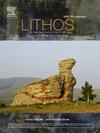Mineralogy and geochemistry of a dunite dyke from the Monchetundra mafic Intrusion (Fennoscandian Shield): Evidence for petrogenesis and ophiolite-type affiliation
IF 2.9
2区 地球科学
Q2 GEOCHEMISTRY & GEOPHYSICS
引用次数: 0
Abstract
Numerous dyke- and sill-like dunites have been discovered in the Paleoproterozoic Monchetundra mafic intrusion (MMI) located northeast of the Fennoscandian Shield. The subject of our study was a 35-m-thick dunite dyke discovered during exploration drilling of the low-sulfide Pt![]() Pd Loypishnyun deposit. These dunites contain a xenolith of the amphibolized orthopyroxenite and have undergone uneven, locally intense serpentinization, resulting in serpentinite formation. The host norites and orthopyroxenites underwent tectono-thermal transformations at contact with the dunites in the form of thin zones of serpentine-tremolite, tremolite, and cummingtonite rocks. These dunites are important because they record magmatic events after the formation of the MMI associated with the reactivation of the cratonic mantle. This study reports the mineral composition and the whole-rock major and trace element contents in 23 samples collected from dunite section and host rocks. The primary magmatic minerals in the dunites were olivine (Fo86.7–92.7) with an elevated Ni content (up to 0.57 wt% NiO) and accessory chromite (60–85 %Cr#). Dunites are characterized by high magnesium (80–87 %Mg#), nickel (1590–2990 ppm Ni), chromium (up to 1.7 wt% Cr2O3), and iron oxidation coefficient (82–65 %Fe3+#). They are depleted in rare earth elements (1.3–0.43 ppm REEtot), Ta, Sr, Zr, and Hf and are enriched in U, Th, and Ti. Based on Cr# (Chr)/Fo (Ol) and V/Al2O3 ratios, the parental magma of the dunites formed as a result of partial (30–40 %) melting of the fertile MORB mantle. Dunite crystallization occurred at 1355–1060 °C under the control of the FMQ buffer. Comparative analysis showed that the MMI dunites are similar in olivine composition to the alpine-type Pados intrusion and the Phanerozoic ophiolites of Oman, have a closer chromite composition to the Finnish Paleoproterozoic ophiolites, and generally similar in chemical composition to all except for lower SiO2 and CaO contents in the MMI dunites. In the REE patterns, the MMI dunites were closest to those of Pados. We suggest that the formation of MMI dunite dykes was associated with the rise of parental melt through a crack network in the continental crust. This process is likely associated with extensional conditions resulting from the uplift of a mantle diapir. The results obtained indicate that MMI dunites are most likely ophiolite-type intrusive bodies and they characterize the setting of the initial stage of oceanic crust formation in the northeastern Fennoscandian Shield.
Pd Loypishnyun deposit. These dunites contain a xenolith of the amphibolized orthopyroxenite and have undergone uneven, locally intense serpentinization, resulting in serpentinite formation. The host norites and orthopyroxenites underwent tectono-thermal transformations at contact with the dunites in the form of thin zones of serpentine-tremolite, tremolite, and cummingtonite rocks. These dunites are important because they record magmatic events after the formation of the MMI associated with the reactivation of the cratonic mantle. This study reports the mineral composition and the whole-rock major and trace element contents in 23 samples collected from dunite section and host rocks. The primary magmatic minerals in the dunites were olivine (Fo86.7–92.7) with an elevated Ni content (up to 0.57 wt% NiO) and accessory chromite (60–85 %Cr#). Dunites are characterized by high magnesium (80–87 %Mg#), nickel (1590–2990 ppm Ni), chromium (up to 1.7 wt% Cr2O3), and iron oxidation coefficient (82–65 %Fe3+#). They are depleted in rare earth elements (1.3–0.43 ppm REEtot), Ta, Sr, Zr, and Hf and are enriched in U, Th, and Ti. Based on Cr# (Chr)/Fo (Ol) and V/Al2O3 ratios, the parental magma of the dunites formed as a result of partial (30–40 %) melting of the fertile MORB mantle. Dunite crystallization occurred at 1355–1060 °C under the control of the FMQ buffer. Comparative analysis showed that the MMI dunites are similar in olivine composition to the alpine-type Pados intrusion and the Phanerozoic ophiolites of Oman, have a closer chromite composition to the Finnish Paleoproterozoic ophiolites, and generally similar in chemical composition to all except for lower SiO2 and CaO contents in the MMI dunites. In the REE patterns, the MMI dunites were closest to those of Pados. We suggest that the formation of MMI dunite dykes was associated with the rise of parental melt through a crack network in the continental crust. This process is likely associated with extensional conditions resulting from the uplift of a mantle diapir. The results obtained indicate that MMI dunites are most likely ophiolite-type intrusive bodies and they characterize the setting of the initial stage of oceanic crust formation in the northeastern Fennoscandian Shield.
求助全文
约1分钟内获得全文
求助全文
来源期刊

Lithos
地学-地球化学与地球物理
CiteScore
6.80
自引率
11.40%
发文量
286
审稿时长
3.5 months
期刊介绍:
Lithos publishes original research papers on the petrology, geochemistry and petrogenesis of igneous and metamorphic rocks. Papers on mineralogy/mineral physics related to petrology and petrogenetic problems are also welcomed.
 求助内容:
求助内容: 应助结果提醒方式:
应助结果提醒方式:


